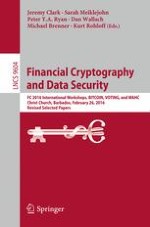2016 | Buch
Financial Cryptography and Data Security
FC 2016 International Workshops, BITCOIN, VOTING, and WAHC, Christ Church, Barbados, February 26, 2016, Revised Selected Papers
herausgegeben von: Jeremy Clark, Sarah Meiklejohn, Peter Y.A. Ryan, Dan Wallach, Michael Brenner, Kurt Rohloff
Verlag: Springer Berlin Heidelberg
Buchreihe : Lecture Notes in Computer Science
